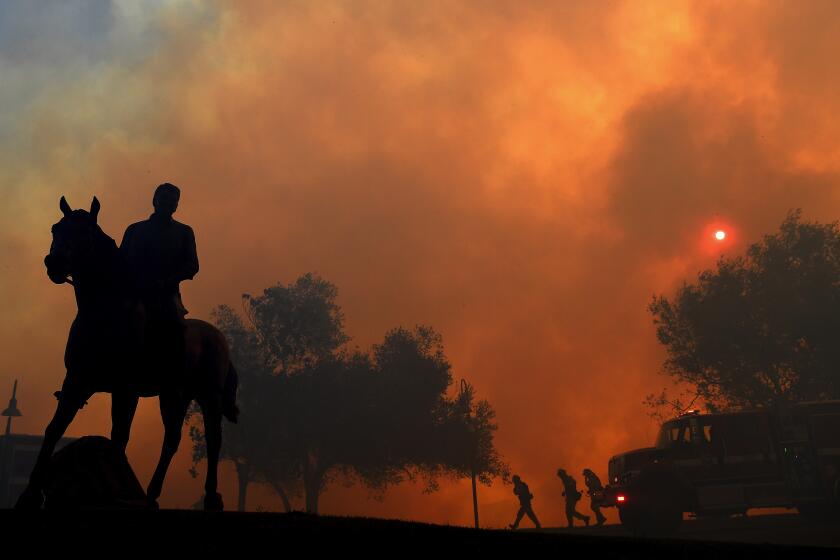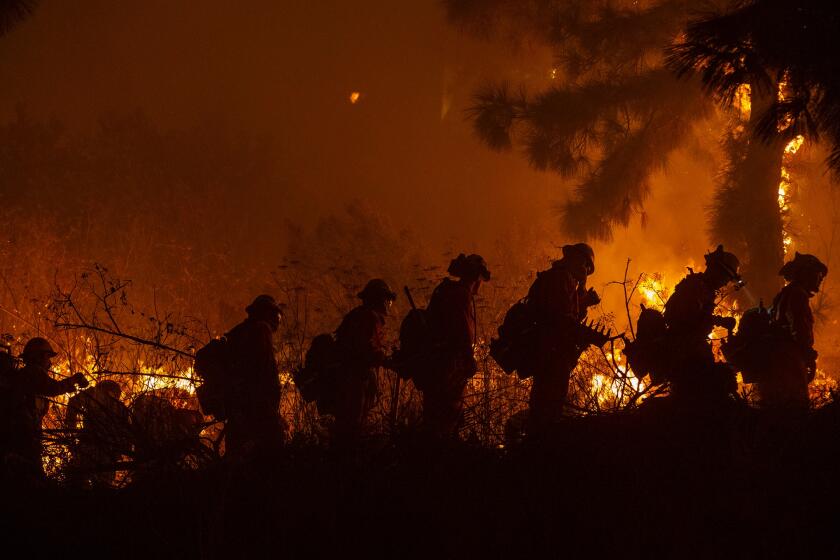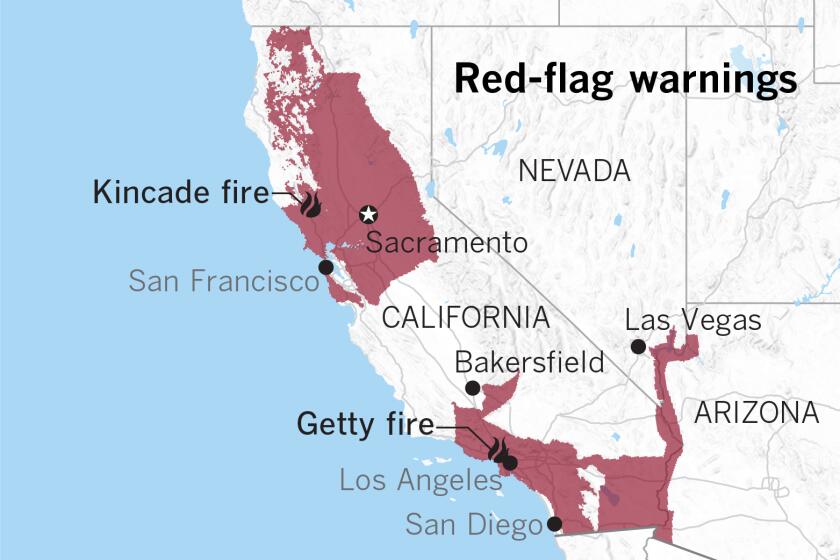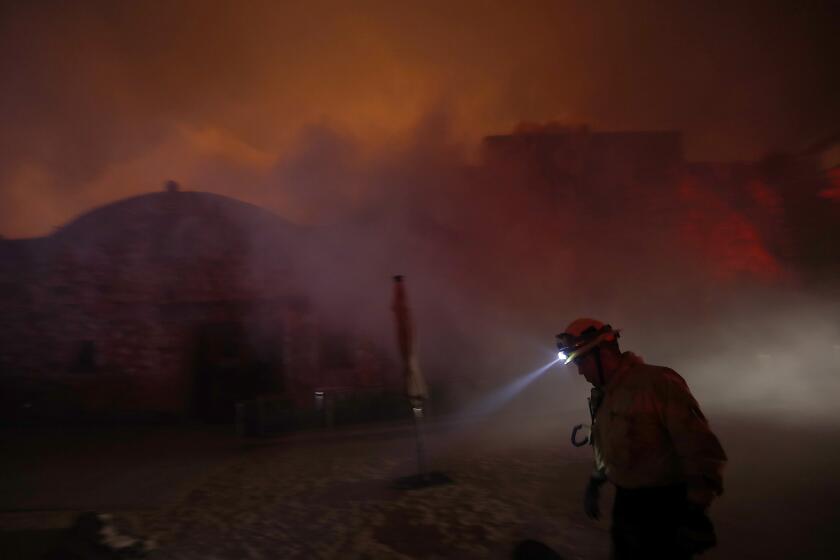Utilities are shutting down power amid fire danger, but the DWP keeps the lights on. Should it?
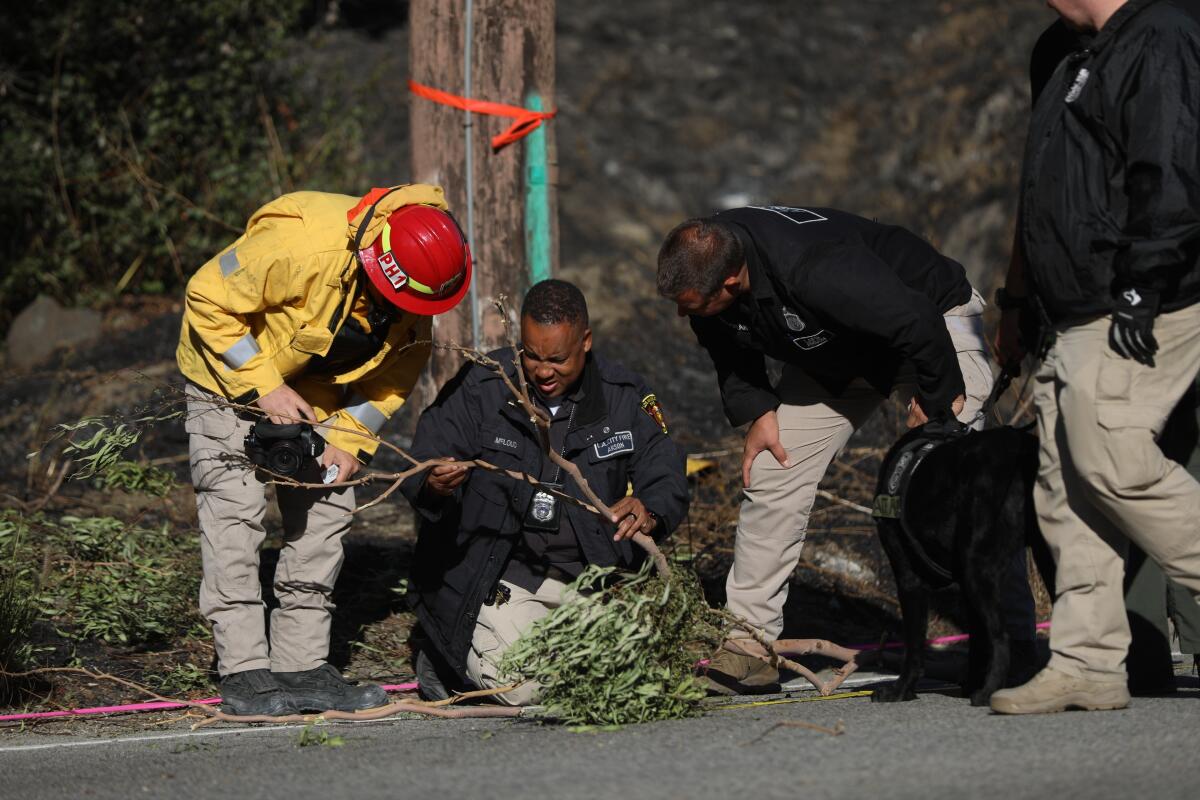
- Share via
When strong winds hit California, utility companies increasingly cut power to neighborhoods across the state to try to reduce the threat of wildfires. This week alone, Pacific Gas & Electric and Southern California Edison blacked out tens of thousands of homes as historic winds struck.
But in Los Angeles, the Department of Water and Power continues to keep the switch on, permitting electricity to course through its 6,000 miles of power lines, even when the fire threat grows.
The long-held policy could come under increasing scrutiny, however, as fire seasons grow longer and damage tolls keep rising. This week’s blaze near the Getty Center, for some residents, was reason enough to re-evaluate the approach.
Red-flag warnings have been extended for the windiest spots of L.A. and Ventura counties, but the unusually long Santa Ana wind event is expected to ease. No rain is in the forecast, though.
One of the utility’s power lines along the 405 Freeway was believed to have been struck by a dried eucalyptus tree branch that broke off during high winds, according to the DWP. Sparks from the electrified line ignited a brush fire that eventually destroyed 12 homes and forced thousands of residents to evacuate, officials said.
DWP officials said there was no failure of electrical equipment and that utility crews had cleared the area of vegetation in July, as required by fire safety codes.
Despite the preparation, blazes around the 405 Freeway can halt traffic and upend the city’s Westside. The Getty fire took place in an area designated by the state as an “elevated high-fire zone,” according to utility officials. Nearly 30% of Los Angeles’ land area falls within the zone, officials said.
The utility, officials said, does not shut off service to customers during a high-wind event, in part because the utility serves an urban area where the fire risk is lower and because firefighters can rapidly respond to any blaze.
Turning off power in a densely populated city such as Los Angeles presents its own set of issues, affecting everything from traffic lights to hospitals, said DWP general manager Marty Adams.
Forecasters have labeled Santa Ana winds expected Tuesday and Wednesday an “extreme red flag,” warning — a rare term underscoring the potential danger.
“You’re talking about essentially handicapping the city from functioning,” Adams said. “Do you put major parts of the city out of power, which means putting people out of business?”
Instead, the utility’s fire management plan include pruning vegetation around its equipment. DWP officials said the eucalyptus was more than 30 feet from the power pole, beyond the area that the utility is required to clear.
The city’s fire department supports the DWP policy of not shutting off power, said LAFD spokesman Peter Sanders.
As for the property where the branch snapped off, Sanders wrote in an email that the land appears to be owned by C and C MountainGate Inc. Representatives of the MountainGate Country Club golf course, which is near the Getty along the 405 Freeway and was closed this week because of the fire, were not available for comment.
Los Angeles City Councilman Paul Koretz, whose district includes the hillside neighborhoods of Bel-Air and Beverly Crest, plans to introduce a motion that would ask the city to study whether it should ground power lines in fire-prone areas, his spokeswoman Alison Simard said.
Red-flag warnings in California signal a dry, windy environment ripe for rapid fire growth
Gregg Landis, who manages the Bel Air Glen Homeowners Assn., supports burying power lines. But in in the short term, he said, the DWP should look at turning off power in areas that have burned before, such as the Sepulveda Pass. Landis said most inconveniences would be manageable if neighborhoods have advance notice. “It’s a day or two” without power, he added.
Across California, the power shut-downs have been met with a mix of anger and grim acceptance, as utility officials weigh the risks of exposure posed by each high-wind event.
Anticipating strong winds, San Diego Gas & Electric turned off power this week to some of its 3.6 million customers. Most of those affected live in rural areas, but the blackouts also extended to populous communities including Encinitas and Rancho Santa Fe, said utility spokeswoman Ashley Bernhardt.
SDG&E has de-energized lines since 2013, and is recognized by the state as a leader in performing targeted outages. Those outages focus on shutting down the distribution lines that serve neighborhoods facing safety risks, a practice that allows electricity to keep flowing to some customers while turning off power to others on the same circuit.
However, the ownership structure of a utility can guide policy-making. SDG&E, Edison and PG&E are investor-owned utilities and are solely in charge of their liability costs. The DWP is part of Los Angeles city, putting residents on the hook for potential fire costs. “If the DWP was a private company, it would face different decisions,” Adams said.
PG&E could shut off power to 605,000 customers Tuesday and Wednesday. Southern California Edison could shut off power to more than 350,000 customers.
Under state law, utilities must pay for damages to homes and property if its power equipment causes a fire, even if there was no negligence on the part of the utility.
The DWP has wildfire insurance, but its premiums have risen 20% in the last few years, a “cost that directly affects our ratepayers,” Adams said. However, he added that other utilities have seen steeper jumps in insurance costs.
In one of the most-high-profile incidents, DWP’s insurers paid out $100 million after the 2013 Powerhouse fire near Santa Clarita, a utility spokeswoman said. That blaze started near DWP equipment and lasted more than a week, destroying dozens of structures, burning more than 30,000 acres and prompting lawsuits. A spokeswoman said the DWP admitted no liability in the fire.
Barbara Broide, president of the Westwood South of Santa Monica Boulevard Homeowners Assn., donned a paper mask to do yardwork this week as the hillsides around the Getty Center smoldered.
Targeted blackouts in L..A’s fire-prone hillsides probably make sense, Broide said, but she worried that widespread outages would shut down traffic lights and home security systems. “It’s just not practical to turn off power in huge swaths of the city,” she said.
More to Read
Sign up for Essential California
The most important California stories and recommendations in your inbox every morning.
You may occasionally receive promotional content from the Los Angeles Times.
